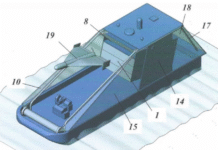Ukraine is building an «anti-drone dome»: mass production of “The Sting” interceptors”
Ukraine moves to mass production of low-cost FPV interceptors The Sting from the company Wild Hornets and partners. The device demonstrates very high speed performance - up to 315 km/h - and a relatively low price (approximately $2 100-2 500 per unit), which makes it one of the main tools for creating local «anti-drone domes». The Ukrainian government and manufacturers aim to increase the daily output to 1,000 interceptors for massive counteraction to kamikaze attacks.
What is The Sting and how it works
The Sting - is a compact «hunter drone» designed to intercept and physically destroy Shahed/Geran attack UAVs. The shape of the vehicle and its design solutions allow it to achieve the high speeds and manoeuvrability required to intercept kamikazes. The test videos show how the vehicle accelerates to the values shown and hits the target.
Production scale: ambition and reality
Ukrainian coordination of private, volunteer and state resources is aimed at accelerating the mass production of such devices. Official and public sources report the plan to increase the daily launch of interceptors to 1,000 units, This should help repel massive drone attacks. At the same time, analysts note that to ensure reliable protection, even more devices may be needed, depending on the intensity of enemy attacks.
Efficiency: how much is actually lost
The manufacturer and related volunteer platforms publicly claim hundreds of enemy UAV sightings, with various reports citing numbers ranging from several hundred to over 600 destroyed drones. Official independent verification of these estimates is partly difficult due to the nature of the fighting and the multiplicity of sources; analysts call for such data to be considered operational estimates that need further confirmation.
Advantages of the approach
Cost versus efficiency: The Sting is significantly cheaper than classical missile interceptors, making mass production economically feasible.
Production flexibility: Local workshops, 3D printing and volunteer chains allow for rapid scaling.
Fast modernisation: manufacturers promptly improve the design in response to tactical challenges.
Limitations and risks
The need for operators and automation: mass use requires pilot training or the introduction of reliable auto-support.
Resource intensity: several interceptors can be used for a single kill guarantee, which increases the daily consumption of components.
Evolution of the enemy: The enemy is developing faster and more sophisticated media, and the need for innovation is growing.
What does this mean for Ukraine
Mass production The Sting will create a large-scale, inexpensive and operational level of protection against kamikaze - effectively covering critical infrastructure, logistics hubs and rear posts. If the plans for daily production are implemented, this will seriously complicate the enemy's logistics and reduce the effectiveness of its massive strikes. However, the real benefit will depend on the stability of the supply of components, the quality of personnel training, and how well these interceptors are integrated into a multi-layered air defence system.




